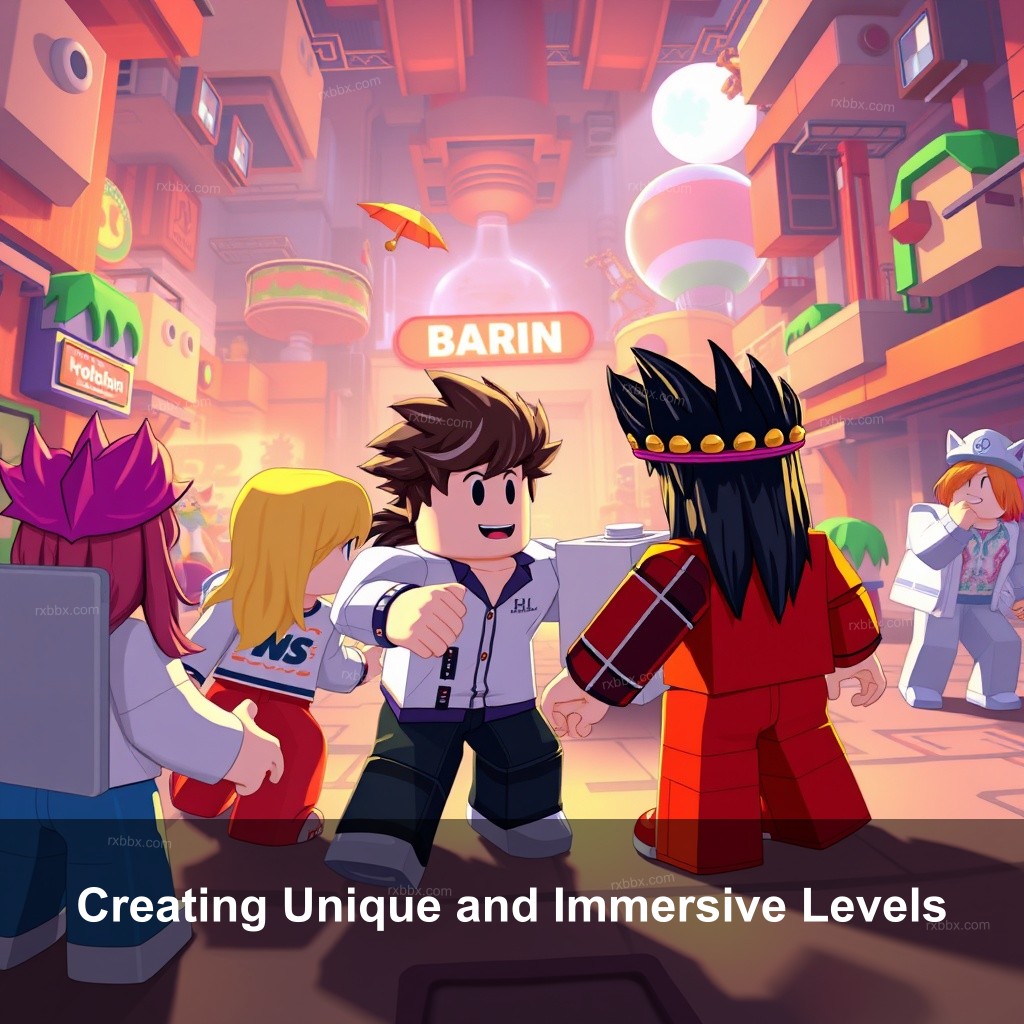Did you know that level design is one of the most crucial aspects of game development? Good level design in Roblox can make or break player engagement. At the RxBBX Gaming Hub, we’re excited to share some effective tips for designing levels that players will love. In this post, we’ll cover best practices, creative techniques, and insights into creating immersive experiences in Roblox.

Tips for Effective Level Design in Roblox
Level design combines science and art. It shapes players’ interactions with the game environment. Roblox requires you to strike a mix of aesthetics, utility, and user experience to generate interesting levels. Here are some important ideas you ought to apply.
Understanding Roblox Level Design Principles
Before you start building, it’s important to grasp the core principles of level design. These principles will guide your design decisions and help create a more engaging player experience.
- Importance of User Experience: Focusing on how users interact with designs is necessary. Players should feel comfortable navigating your levels. If they struggle, they might leave your game frustrated. A good design starts with understanding player behavior. For instance, do players prefer exploration or quick actions? Observing how players engage can provide valuable insights.
- Balancing Aesthetics and Functionality: Striking a balance between visual appeal and usability is key. A level that looks great but is hard to navigate will frustrate players. Analyze popular games in Roblox. Many use appealing visuals that don’t compromise gameplay. They create stunning backdrops that enhance the gaming experience without overwhelming the player.
- Incorporating Player Feedback: Using player suggestions to improve gameplay is priceless. Always be open to feedback and ready to make adjustments. A great example is how community-driven games evolve. Developers listen to players and implement changes based on their experiences, making the game better over time.
How to Design Levels in Roblox
Let’s get into the nitty-gritty of designing levels. Knowing how to use tools effectively is half the battle!
- Planning Your Level Layout: Importance of sketching out levels before building. A rough plan can save time and help avoid pitfalls later. Consider using graph paper or digital tools to layout your designs. Think about player flow and how they will experience each area.
- Utilizing Roblox Studio Effectively: Key features of Roblox Studio can aid level design. Familiarize yourself with the toolbox and terrain features to create more dynamic environments. Check out the Roblox Studio scripting tutorial for tips on using these tools. Knowing how to manipulate objects can lead to more creative designs.
- Testing and Iterating Your Design: The necessity of testing levels for user engagement cannot be understated. Playtesting helps identify issues that may not be apparent during the design phase. Invite friends to test your game, and their feedback can unveil areas needing improvement or elements that might not be clear.
Roblox Level Design Best Practices
Now that you have the basics down, let’s look at some best practices to take your designs to the next level.
- Setting Clear Objectives for Levels: Establishing goals for player progression is key. Players should know what they need to accomplish in each level. Examples include collecting items or defeating enemies. Make these objectives clear through visual cues or objectives displayed on-screen.
- Creating Engaging Interactive Elements: The role of interactive features in maintaining player interest is significant. Players enjoy levels that offer something more than just a straight path. Consider adding puzzles, hidden areas, or challenges. These elements can create excitement and encourage exploration.
- Designing for Replayability: Strategies to make levels enjoyable on multiple playthroughs can include randomizing aspects or offering different pathways. Games with high replay value often incorporate new experiences in each playthrough, enticing players to return.
Low Competition Level Design Tips
With a crowded space, it’s important to find ways to stand out. Here are some strategies for low competition design.
- Leveraging Roblox Terrain for Unique Levels: How to use terrain features to improve level design. The unique terrain options in Roblox can make your game visually appealing. Experiment with hills, valleys, and rivers to create dynamic environments. This can add depth and interesting pathways for players.
- Incorporating Immersive Level Design Techniques: Strategies for creating captivating environments can include thematic elements, sound design, and visual storytelling. Use sound effects to create atmosphere. Background music can also engage players in the game world and improve their experience.
- Maximizing Interactive Gameplay: Importance of interactive elements in gameplay design. The more players engage with your levels, the more they will enjoy them. Think about how players can interact with objects, environment, or even each other to create a lively experience.

Creating Unique and Immersive Levels
Creativity is key in keeping players engaged. Here’s how to make your levels stand out.
- The Role of Narrative in Level Design: How storytelling can improve gameplay. A captivating story can be a great lure for players. Consider creating a backstory for your levels. It adds layers to the gameplay and encourages players to find out more.
- Using Sound and Visual Effects: Improving immersion through audio and visual design can significantly affect how players perceive your game. Use sounds to signal events or changes in gameplay. Visual effects can communicate important gameplay elements without cluttering the screen.
- Encouraging Player Exploration: Techniques to motivate players to check every corner of a level can include rewards for finding hidden areas. Make sure to hide Easter eggs or collectibles throughout your game. This encourages players to search for more and improves engagement.
Addressing Common Level Design Challenges
Every designer faces challenges. Here are some common issues and how to solve them.
- Balancing Difficulty Across Levels: How to adjust difficulty to suit various player skills. A level should challenge players, not overwhelm them. You might want to gather feedback from testers on difficulty. Adjust based on who finds it too easy or too hard.
- Overcoming Technical Limitations: Strategies for designing within Roblox’s technical limits. Understanding what Roblox can handle will help you avoid performance issues. Optimize your assets to make sure that levels run smoothly.
- Engaging Players with Multiplayer Features: Designing levels that help social interaction is a must in many Roblox games. Multiplayer experiences should encourage cooperation or competition. Consider how players can interact with each other in your level, such as through challenges, team objectives, or shared loot.
FAQ
What are the best practices for Roblox level design?
Best practices include understanding user experience, creating engaging interactive elements, and testing your designs frequently. Always keep player feedback in mind.
How can I make my Roblox levels more engaging?
Incorporate interactive gameplay elements, unique narratives, and immersive sound design. The more players can engage and feel a connection to the world, the more engaged they will be.
What tools can help me design levels in Roblox?
Roblox Studio is the primary tool for level design. It offers features for creating terrain, scripting, and testing your game. Check out the Comprehensive guide to Roblox Studio for more tips.
How do I test my Roblox levels?
Invite friends or community members to playtest your levels. Gather their feedback, focusing on aspects like enjoyment, clarity of objectives, and difficulty.
What are common mistakes in level design?
Common mistakes include neglecting user experience, overcrowding the level with details, and failing to test for technical constraints. Always prioritize player engagement.
Conclusion
In summary, effective level design in Roblox requires a mix of creativity, technical skills, and player-focused strategies. By following best practices, understanding your audience, and continuously testing, you can create levels that captivate players. At RxBBX Gaming Hub, we hope these tips inspire you to start building your next great experience in Roblox. Feel free to explore your creativity and share your thoughts or experiences in the comments!
